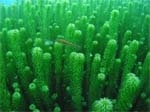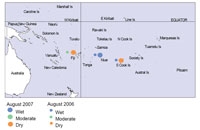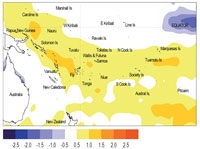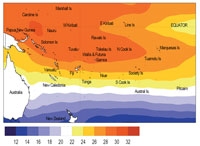Climate developments in August 2007

The South Pacific Convergence Zone (SPCZ) continued to affect the Solomon Islands and northern parts of Fiji, extending east with weakly enhanced convection over Tuvalu and north of Samoa, and little activity further east. Convergence was also weakly enhanced over Australia’s tropical east coast (where some unseasonably heavy rainfalls occurred) extending east across the north Tasman Sea. An elongated region of suppressed convection persisted along the equator from the region south of the Caroline Islands across Western and part of Eastern Kiribati and then further east (north of the Equator towards South America). Suppressed convection also affected the western and southern parts of Fiji, under the influence of the subtropical high pressure system.
Rainfall was 200% or more of normal in the north of Vanuatu and parts of central and southern French Polynesia, and also above normal in the south of New Caledonia, the north of Fiji, and much of Tuvalu. August rainfall was 50% or less of normal throughout the western and southern parts of Fiji. Only 1 mm was recorded at Nadi. It was dry in northern parts of New Caledonia.
August mean air temperatures were 1.0 °C or more above normal in parts of Tuvalu, Tonga, Fiji, much of New Caledonia, and central and southern French Polynesia. New Caledonia was unusually warm for August, and Fiji has been exceptionally warm with above average temperatures throughout the June-August period.
Tropical Southwest Pacific mean sea-level pressures were below average near 5°S of the Equator about and east of the Date Line, with high pressures south of 25°S in the eastern South Pacific.
Equatorial surface easterlies weakened by 10% in August, occurring in about 75% of observations at Tarawa, however, they were still quite persistent. The southeast trade winds were weaker than normal over Fiji. Enhanced trade winds occurred in the eastern South Pacific.
| Country | Location | Rainfall (mm) | % of average | Comments |
|---|---|---|---|---|
| Fiji | Nadi | 1 | 2 | Extremely low |
| New Caledona | Ile Art, Beleep | 11 | 22 | Well below average |
| New Caledona | Moue | 185 | 208 | Well above average |
| Vanuatu | Lamap | 159 | 269 | Well above average |
| French Polynesia | Tubuai | 326 | 240 | Extremely high |
| Country | Location | Mean temp.(°C) | % of average | Comments |
|---|---|---|---|---|
| New Caledonia | Noumea | 21.3 | +1.2 | Extremely high |
| Fiji | Nadi Airport | 25.4 | +1.8 | Extremely high |
| Tuvalu | Funafuti | 29.2 | +1.3 | Extremely high |
| Tonga | Fua’amotu Airport | 22.5 | +1.4 | Extremely high |
| French Polynesia | Tahiti-Faaa | 26.0 | +1.3 | Extremely high |
| French Polynesia | Rapa | 19.3 | +1.5 | Extremely high |
Soil moisture in August 2007

Estimates of soil moisture shown in the map (right) are based on monthly rainfall for one station in each country. Currently there are not many sites in the water balance model. It is planned to include more stations in the future.
The information displayed is based on a simple water balance technique to determine soil moisture levels. Addition of moisture to available water already in the soil comes from rainfall, and losses via evapotranspiration. Monthly rainfall and evapotranspiration are used to determine the soil moisture level and its changes.
Please note that these soil moisture calculations are made at the end of the month. For practical purposes, generalisations were made about the available water capacity of the soils at each site.
At the end of August 2007, Rarotonga soils were dry for the second consecutive month, and Nadi soils were also dry, with mild drought-like conditions in the northwest and west of Viti Levu and Kandavu. Hanan soils remained moist (at field capacity).
El Niño/Southern Oscillation (ENSO)


Conditions in the tropical Pacific are in a borderline La Niña state, and these indicators have strengthened over the last month.
Sea surface temperature (SST) in the equatorial Pacific became more strongly negative east of 140°W with anomalies expanding westward during August, the oceanic anomaly field showing a weak La Niña pattern, with an enhanced ‘cold tongue’ evident near the South American coast (and northeast of Northern French Polynesia) and a partial ‘warm horseshoe’ in the extratropics of both hemispheres (also evident in SSH anomalies). The NINO3 anomaly decreased to –0.9 °C in August (June-August average -0.5) and the NINO4 anomaly was +0.3 °C (June-August mean also +0.3 °C). During August equatorial subsurface temperatures showed a significant negative anomaly (-2 °C) in the top 150 metres in the eastern Pacific, with positive anomalies (+1 °C) in the same layer west of the Date Line.
Equatorial easterlies were stronger than average in the western and central Pacific with suppressed convection near and east of the Date Line. The SOI rose during August to +0.1 (June-August, 0.0).
Tropical OLR anomalies show suppressed convection in the equatorial region near and east of the Date Line, with a weak area of enhanced convection over parts of Indonesia. The TRMM-based ENSO precipitation index was -0.5, in the neutral range. Although the Madden-Julian Oscillation (MJO) is weak, it shows some activity in the Indian Ocean (phase 2).
Overall, these show a weak La Niña in development, with atmospheric and oceanic conditions in the eastern Pacific in a La Niña state, although conditions in the western Pacific do not exhibit this behaviour yet. Model guidance anticipates La Niña conditions to strengthen.
There has been a general strengthening in ENSO model forecasts since July, with 65% of the models showing La Niña conditions through to the end of November, and 50% of the models extending the La Niña into early 2008. Almost all models tend neutral after that.
The Scripps model differs, in that it indicates a warm event developing during the southern summer, persisting into autumn 2008. The NCEP synopsis suggests La Niña conditions will continue to develop and possibly strengthen during spring. The IRI synthesis continues to give a probability of 60% for a La Niña over the next few months. The probability of El Niño conditions re-emerging during the forecast period remains below 10%.
Forecast validation: June to August 2007
Two areas of enhanced convection and above average rainfall were expected, one over the Solomon Islands, and the other affecting Wallis and Futuna, Samoa, the Northern Cook Islands, and the Society Islands. Near or above average rainfall was forecast from Papua New Guinea southeast to the Tuamotu Islands including Vanuatu, Tokelau, Tonga, Niue, and the Southern Cook Islands. Suppressed convection with below average rainfall convection was expected over Eastern Kiribati and Tuvalu, with near or below average rainfall in Western Kiribati. Near average rainfall was expected elsewhere.
Suppressed convection and below average rainfall occurred as expected in the equatorial region about and east of the Date Line, including Western and Eastern Kiribati. Rainfall was also below average (as expected) in Tonga and the Society Islands (drier than expected). Rainfall was above average as expected in Vanuatu and the Tuamotu Islands. The ‘hit rate’ for the June-August 2007 rainfall outlook was about 70%.
